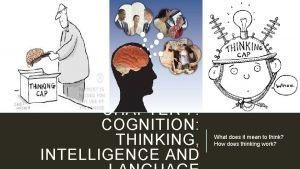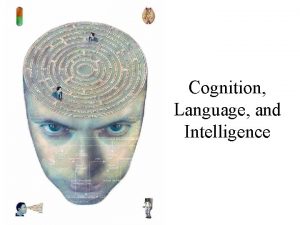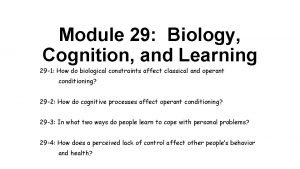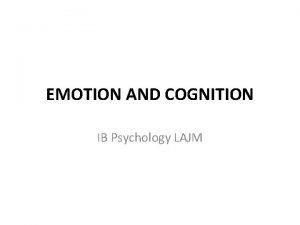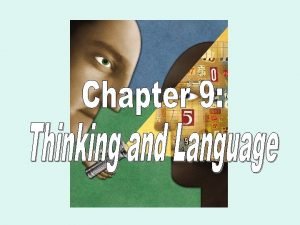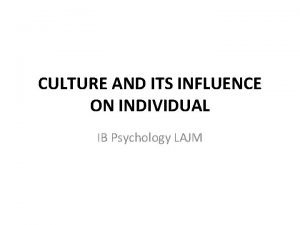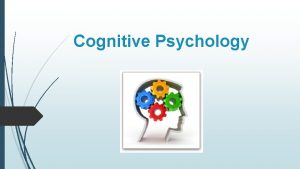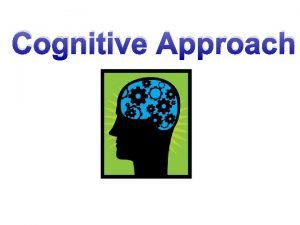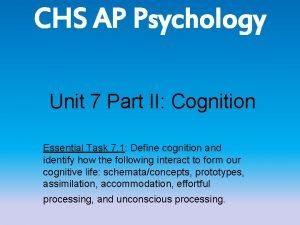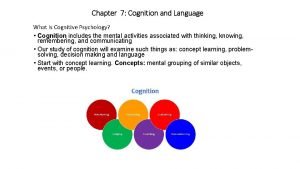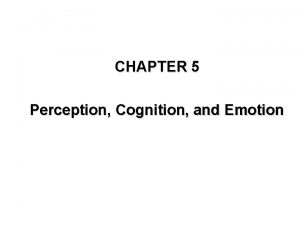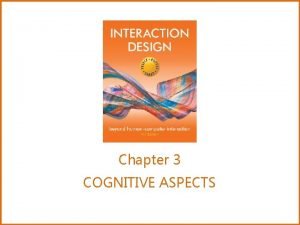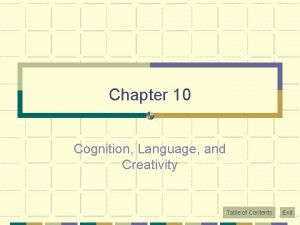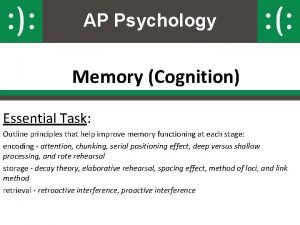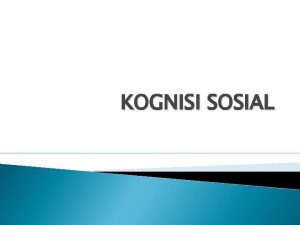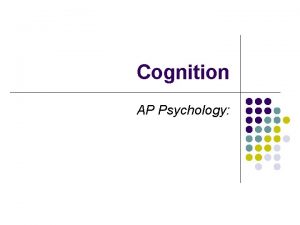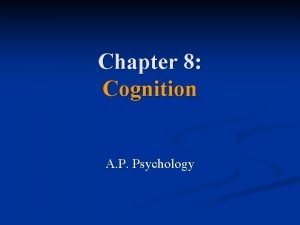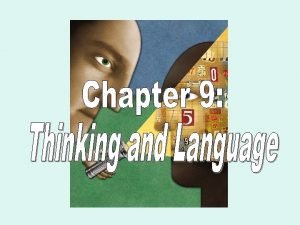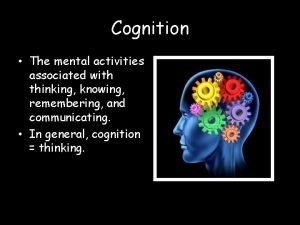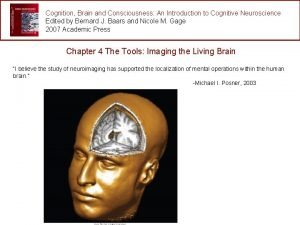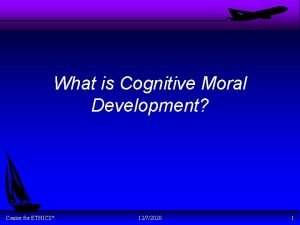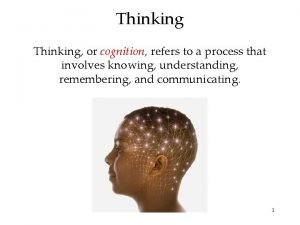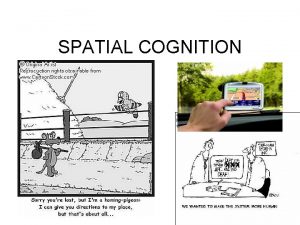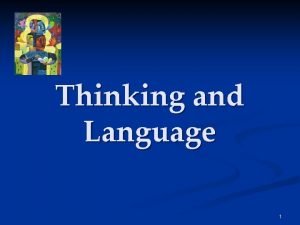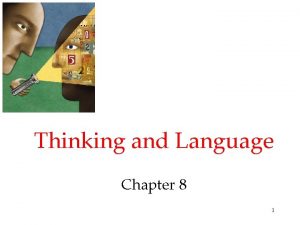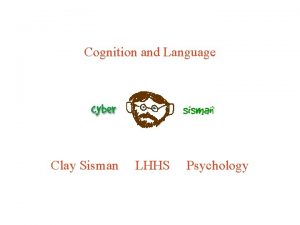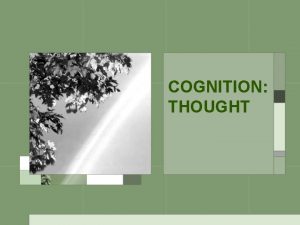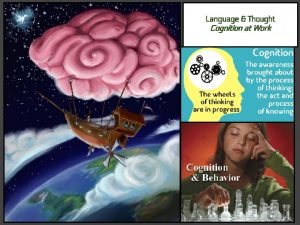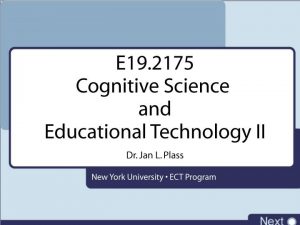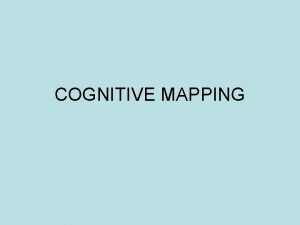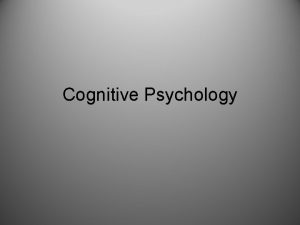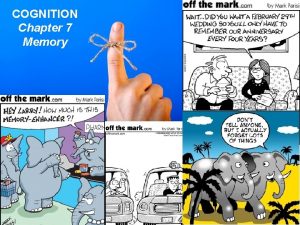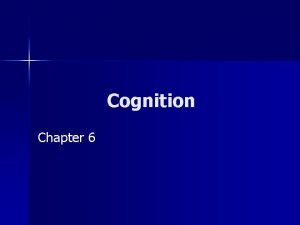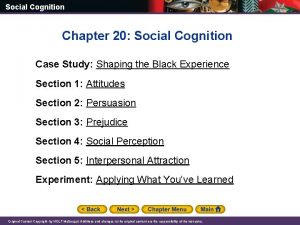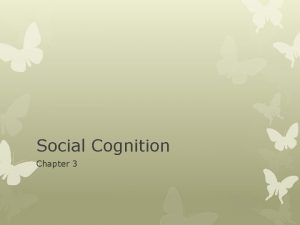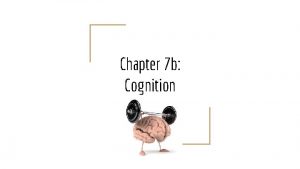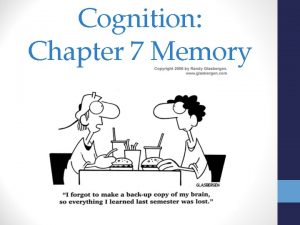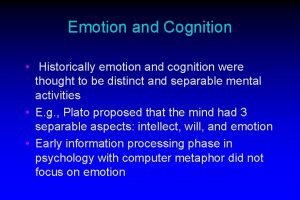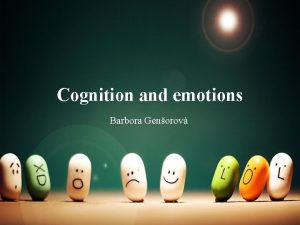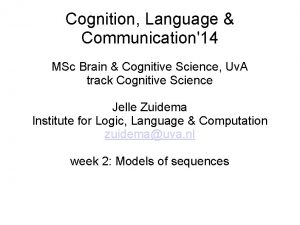Chapter 7 Cognition and Language What Is Cognitive































- Slides: 31

Chapter 7: Cognition and Language What Is Cognitive Psychology? • Cognition includes the mental activities associated with thinking, knowing, remembering, and communicating • Our study of cognition will examine such things as: concept learning, problemsolving, decision making and language • Start with concept learning. Concepts: mental grouping of similar objects, events, or people.

Formal and Natural Concepts • Formal concepts (also known as logical or artificial concepts) have a rigid set of rules or parameters for membership – e. g. , a triangle • Most of our concepts develop through our own experiences in the world and are known as natural concepts – e. g. , colors • A prototype is a typical example that exhibits all of the features associated with a certain category, more likely to be used as comparison for other (novel) objects. Prototypes more likely to be generic and basic

Table 7. 1 From Prototypes to Unusual Examples Note: more generic at top, more specific and we move down table More generic can serve as representatives or comparisons (prototypes) Car= something you get in and it transports you Orange = round, peel, seeds, edible Vehicles Fruit Car Orange Bus Apple Train Peach Bicycle Grape Airplane Strawberry Boat Grapefruit Wheelchair Watermelon Sled Date Skates Tomato Elevator Olive Generic Specific

Classification of Concepts LO 7. 2 Describe the hierarchical model of concept classification. • Hierarchies of concepts: classifying concepts that progress from broad to narrow • The categories that are the broadest, or include the most concepts, are superordinate concepts • Basic concepts provide significantly more information than the superordinate concepts • Subordinate concepts are the most specific type of concepts and include the narrowest categories

Figure 7. 1 A Concept Hierarchy

Problem-Solving Strategies LO 7. 3 Identify different types of problem-solving strategies. • A problem space can be defined in terms of the initial state, the goal state, and the set of operations • We use a variety of different methods for solving different kinds of problems. – trial and error – algorithms – heuristics – means-end analysis

Heuristics vs. algorithms • Heuristics: general problem solving strategies that are often useful but not always effective (in football: control line of scrimmage, avoid turnovers, in chess: control center of board. ) • Algorithms: step by step procedures guaranteed to solve a specific problem (recipe to bake a cake, formula to solve for area of triangle). Very narrow in scope, but guaranteed to work ©John Wiley & Sons, Inc. 2007 in Action (8 e) Huffman: Psychology

Means –End Analysis Initial state (with problem) – goal state (with solution) Problem space – distance that must be traversed to move from initial to goal state Operators: legal moves that can be made to traverse problem space (no magic, nothing illegal or unethical). Lab example: tower of Hanoi problem Real world example: graduating from college (must pass classes, must attend classes, must get up in the morning, must set alarm (no cheating, no paying for a grade, etc. ) ©John Wiley & Sons, Inc. 2007 in Action (8 e) Huffman: Psychology

Challenges with Problem Solving LO 7. 4 Describe different problem-solving difficulties. • Fixation is the inability to see a problem from a fresh perspective because of our tendency to become stuck in our thinking • A mental set is a preexisting state of mind we use to solve problems because it’s helped us solve similar problems in the past • Functional fixedness is a bias that limits your ability to think about objects in unconventional ways

Figure 8. 4 Functional Fixedness: Dunker’s make a lamp problem

Figure 8. 3 Mental Set Problems: Luchins water jar problem

How People Make Decisions LO 7. 5 Identify different theories about how people make decisions. • Rational choice theory states that we make decisions by determining how likely each outcome of that decision is as well as the positive or negative value of each outcome • Prospect theory states that we have a tendency to avoid risk in situations where we stand to gain but to become more risk seeking when facing a potential loss • The presence of dopamine in the brain helps us make decisions that lead to good outcomes and avoid bad outcomes (role of emotions)

Obstacles in Decision Making LO 7. 6 Recognize obstacles that can hinder decision making. • The framing of an issue can influence our decisions • If there are too many alternatives, we develop decision aversion and avoid making any decision at all • The availability heuristic is a mental shortcut that tells us that if we can bring examples of an event to mind easily, that event must be common • The representativeness heuristic is used when trying to make decisions about the probability of an event by comparing it to our existing prototype of the event • Confirmation bias: only look for evidence that supports our pre-dispositions or initial inclinations

Decision-Making biases: Representativeness and Availability • Representativeness—“common category members” • We ignore how common behaviors actually are in a population and commit the base rate fallacy. • Is John the druggie a rock star or accountant? (base rate fallacy) • Availability—“off the top of my head” • We estimate the likelihood of an event based on how easily it comes to mind. Confirmation bias: only looking for supportive evidence

Confirmation Bias LO 7. 7 Describe the role of confirmation bias in decision making. • Confirmation bias is the belief that something is true leads to the tendency to look for evidence that proves our beliefs while failing to notice evidence that disproves those beliefs • It can lead people astray in three ways: 1. Influencing how we seek information 2. Influencing how we interpret information 3. Influencing how we remember information

Figure 7. 3 System 1 and System 2

Creative thinking LO 7. 8 Distinguish between convergent and divergent thinking. • Creativity is the ability to come up with new ideas that can lead to a particular outcome, can involve both convergent and divergent thinking • Convergent thinking occurs when we are confronted with welldefined, straightforward problems that have a right/wrong answer • Divergent thinking includes thought processes used to generate many different possible solutions to a problem

Figure 7. 5 Threshold Theory of Creativity

Sternberg’s Theory LO 7. 9 Explain Sternberg’s theory of creative thinking. • According to the investment theory of creativity, six ingredients must be present for creativity to emerge: 1. Intellectual skills (seeing novel patterns) 2. Knowledge (background in creative area, art, physics, etc. ) 3. Thinking styles (convergent, divergent thought) 4. Personality (openness*, moderately risk-taking) 5. Motivation (persistence) 6. Environment (encouraging of innovation)

Language: symbolic, rule-based system of communication shared by a community • Features of langauge • Phonemes are the smallest units of sound possible in a language • Morphemes are the smallest units that have meaning • Syntax refers to the rules about how words are to be arranged to form sentences • Semantics refers to the meaning of words and sentences in a given language • Grammar combines syntax and semantics to provide a system of rules that governs the way people compose and use language

The Features of Language (2 of 6) LO 8. 3 a Describe the four levels of analysis that make up language. • Phonemes • Categories of sounds that our vocal apparatus produces • Smallest units of sound/gesture in language • Probably around 100 total; each language only uses a subset ranging from 15 to 60 • 40 to 45 in English

The Features of Language (3 of 6) LO 8. 3 a Describe the four levels of analysis that make up language. • Morphemes • The smallest units of meaning in a language • Convey information about semantics—meaning derived from words and sentences • Can be full words (“dog”) or suffixes/prefixes (s, ed) modifiers (“re-”), and other inflections that carry meaning

The Features of Language (4 of 6) LO 8. 3 a Describe the four levels of analysis that make up language. • Syntax • The set of rules of a language for constructing sentences • Includes word order, morphological markers, and sentence structure • Real-world language rarely follows these rules completely.

Language Development • Based on the behavioral model, Skinner believed that children acquire their native language through the process of imitation and reinforcement • Chomsky proposed that humans are born with an innate capacity for acquiring language and the ability to learn the rules of grammar • The critical period hypothesis (CPH) suggests that there is a limited window of opportunity for children to effectively learn language, which is within the first few years of life

Language Development LO 7. 12 Identify milestones in language development. • Children typically develop receptive language skills (the ability to understand language) much sooner than they develop expressive language skills (the ability to communicate with others using language) • Fast mapping is the ability to acquire and retain new words or concepts with minimal exposure • The process of slow mapping occurs when a child acquires a word through a more gradual process that requires repeated exposures

Table 7. 2 Language Development Milestones, Birth to 2 years Age Receptive Language Skill Expressive Language Skill Birth to 3 months • Recognizes caregiver’s voice and calms down if crying • When feeding, starts or stops sucking in response to sound • Reacts to loud sounds • Calms down or smiles when spoken to • Coos and makes pleasure sounds • Has a special way of crying for different needs • Smiles when he or she sees caregiver 4 to 6 months • • Follows sounds with his or her eyes Responds to changes in tone of voice Notices toys that makes sounds Pays attentions to music • Babbles in speech-like way and uses many different sounds, including sounds that begin with p, b and m • Laughs • Babbles when excited or unhappy • Makes gurgling sounds when alone or playing with someone • Babbles using long and short groups of sounds (“tata, upup, bibi”) • Babbles to get and keep attention • Communicates using gestures such as waving or holding up arms • Initiates different speech sounds • Has one or two words (“hi, ” “dog, ” Dada, ” or “Mama”) by first birthday (Holophrasic speech) 7 months to 1 year • Turns and looks in the direction of sound • Listens when spoken to • Understands words for common items such as “cup, ” “shoe, ” or “juice” • Responds to requests (“come here”) 1 to 2 years • Acquires new words on a regular basis • Knows a few parts of the body and can point to them • Uses some one- or two-word questions (“where kitty? ” or “go when asked bye-bye? ”) • Follows simple commands (“roll the ball”) and • Puts two words together (telegraphic speech) understand simple questions (“where’s your shoe? ”) • Uses many different consonant sounds at the beginning of • Points to pictures, when named, in books words

Table 7. 2 Language Development Milestones, 2 -4 years Age 2 to 3 years 3 to 4 years Receptive Language Skill Expressive Language Skill • Increase in understanding of object names • When asked, points to a picture of something named (such as “where is the cow? ” or “show me the airplane”) • Has a word for almost everything (vocab explosion) • Uses two- or three-word phrases to talk about or ask for things • Uses k, g, f, t, d, and n sounds • Speaks in a way that is understood by family members and friends • Names objects or asks for them or to direct attention to them • Hears when you call from another room • Hears the television or radio at the same sound level as other family members • Answers simple “who? ” “what? ” “where? ” and “why? ” questions • Talks about activities at daycare, preschool or friends’ homes • Uses sentences with four or more words • Speaks easily without having to repeat syllables or words

Table 7. 2 Language Development Milestones, 4 -5 years Age 4 to 5 years Receptive Language Skill Expressive Language Skill • Pays attention to a short story and answers simple questions about it • Hears and understand most of what is said at home and in school • Uses sentences that give many details • Tells stories that stay on topic • Communicates easily with other children and adults • Says most sounds correctly, except for a few (j, s, r, v, z, ch, sh, th) • Uses rhyming words • Names some letters and numbers • Uses adult grammar Developmental milestones are universal: all typically-developing children regardless of language.

Language and Thought LO 7. 13 Explain the relationship between language and thought. • The linguistic relativity hypothesis states that the way people think is strongly affected by their native language • There is evidence that the language we speak influences our perceptions of the world

The Brain and Language LO 7. 14 Identify the areas of the brain associated with language. • Broca’s area is the area of the brain in the left frontal lobe associated with the production of speech • Wernicke’s area is the area of the brain in the left temporal lobe focused on language comprehension • When there is damage to the arcuate fasciculus, people develop conduction aphasia and they are unable to repeat words or sentences spoken by other people • The angular gyrus is important in tasks of reading and writing, and damage to this area has been associated with alexia (inability to read) and dyslexia (difficulty with reading)

Figure 7. 7 Language Areas in the Brain
 Cognitive and non cognitive religious language
Cognitive and non cognitive religious language Chapter 7 cognition thinking intelligence and language
Chapter 7 cognition thinking intelligence and language Cognition thinking intelligence and language
Cognition thinking intelligence and language Does language reflect intelligence
Does language reflect intelligence Module 29 biology cognition and learning
Module 29 biology cognition and learning Teacup ib psychology
Teacup ib psychology Cognition and personalization
Cognition and personalization Cognition refers to
Cognition refers to Mental status exam example
Mental status exam example Serial 7s
Serial 7s Odden and rochat ib psychology
Odden and rochat ib psychology What is cognition
What is cognition Cognition definition
Cognition definition Mental set ap psychology
Mental set ap psychology Means end analysis psychology example
Means end analysis psychology example Objectives of perception
Objectives of perception Altered cognition in older adults is commonly attributed to
Altered cognition in older adults is commonly attributed to What is cognition
What is cognition Cognition definition
Cognition definition Priming memory examples
Priming memory examples Cognition ap psych definition
Cognition ap psych definition Konsep ketersediaan heuristik
Konsep ketersediaan heuristik Chomsky ap psychology
Chomsky ap psychology Belief bias ap psychology
Belief bias ap psychology Embodied cognition ap psychology
Embodied cognition ap psychology Cognition refers to
Cognition refers to The mental activities associated with thinking
The mental activities associated with thinking Complex cognition
Complex cognition Moral cognition
Moral cognition Conjunction fallacy psychology
Conjunction fallacy psychology Xxxفضایی
Xxxفضایی Cognition refers to
Cognition refers to


